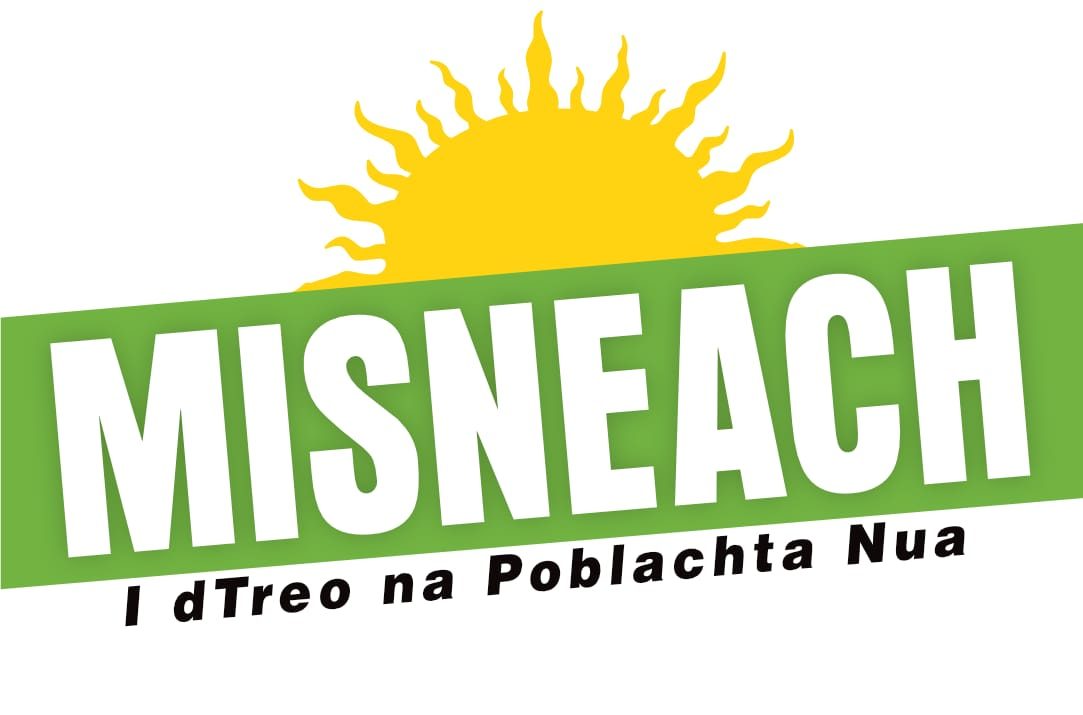Alt a scríobh Rúnaí Misneach, Kerron Ó Luain, do ICEC, eagraíocht a ghníomhaíonn ar son cearta na náisiúin bheaga gan stáit san Eoraip agus atá mar fhóram do ghluaiseachtaí sóisialta. Pléann an t-alt na constaicí atá ag feidhmiú i gcoinne na teanga; cúrsaí tithíochta san áireamh. Scríobhadh an t-alt roimh figiúirí daonáireamh 2022 a bheith foilsithe – figiúirí a léirigh tuilleadh den mheath leanúnach ar líon na gcainteoirí laethúla.
Irish, or Gaeilge, is a Goidelic language which derived from Insular Celtic. It is closely related to Scottish Gaelic and Manx. Speakers of these three languages are sometimes mutually intelligible. Beyond a shared linguistic heritage, all three languages, like that of their related Celtic cousins Welsh and Cornish, are greatly impacted by British imperialism.
Irish is unique among the Celtic languages, and indeed it is an outlier in terms of minority languages in Europe. Part of the territory within which is it is spoken is politically independent. This political self-determination was fought for by armed means during the years 1919-21. The 1916 Rising, which preceded those years was, in large part, a response to the demise of the Irish language over the course of the nineteenth century.
The language declined, in particular, following the triumph of British capitalism in erasing 2 million people from Ireland during the years of the Great Famine of 1845-52. The ideology of the leaders of the 1916 Rising crystallised in the revival organisation Conradh na Gaeilge [The Gaelic League], founded in 1893, in opposition to this decline and to continued British rule.
In the, mostly southern, Twenty-Six Counties of Ireland the language has official status and various legal protections. In the years after independence was gained in 1922, Irish was institutionalised within the structures of the state and education system.
However, the revival ran out of steam during the mid-twentieth century as it revolved primarily around the middle class – teachers, civil servants and priests. It did nothing to alleviate the endemic problems of mass emigration and poverty among a small farming and labouring class in the areas where the language was strongest, in the West.
The opening up of the economy to globalisation in the 1960s saw a further retrenchment of Irish within the state.
The latest census figures from 2016 show that 1,761,420, or 39.8% of the population, claim some knowledge of Irish.
This figure is deceptive, however, and many who say they can speak Irish do so as they view the language as an ethnic symbol, rather than something practical that might be incorporated into daily life. Around 74,000, or 2% of the population speak the language on a daily basis.
The first census taken by the newly independent state in 1926 revealed that there were 543,511 Irish speakers – people who actually spoke the language regularly. This represented 18.3% of the population at the time. Therefore, in the 101 years since a form of independence was achieved in 1922 the state has presided over a 16% drop in native Irish speakers.
A salutary caution, surely, to anyone in minority language communities who might view political independence as a simple panacea to the pressures their languages face.
In the Six Counties of the North, Irish speakers have had to contend not only with the hegemony of the English language but also with the continued hostility and intransigence of local British Unionists. The Partition of Ireland by the Government of Ireland Act 1920 severed the Irish nation in two. It left nationalists and Irish speakers in the Six Counties at the mercy of a hostile supremacist regime.
Unionists viewed Irish as a foreign language and, furthermore, as an existential threat to the state they controlled. A series of acts were introduced throughout the twentieth century which marginalised the language in the education system and the public sphere.
Yet, out of a total of around 1.9 million people in the Six County state 12.4% of the population said they had some knowledge of Irish in the recent census taken in 2021.
This represented a rise from 10.65% in 2011 and is the result of a decades long revival that emerged in earnest in the 1970s. Most positively, the number of people who said Irish was their main language rose from 4,164 in 2011 to 5,969 in 2021.
Like any minority language – especially one that exists in two different jurisdictions and political contexts – there are different sites of struggle and points of focus. In the North, in recent years, the objective has been the winning of fundamental language rights, an Irish Language Act, which was denied for many years despite being promised in the Good Friday Agreement of 1998, the 25th anniversary of which is this year.
The Acht Anois [Act Now] campaign driven by An Dream Dearg [The Red Group] has achieved its initial objective. The Identity and Language (Northern Ireland) Bill passed the initial stages of parliament in Westminster last year.
This was only achieved following a protracted grassroots struggle which culminated in 20,000 people marching through Belfast in May 2022.
Irish speakers in the southern Twenty-Six Counties require a similar movement. However, it is, perhaps, more difficult to coalesce around a campaign that has numerous demands, and is aimed at a “benevolent” government, than it is around one clear objective demanded from hostile political actors.
There is also a different class basis to the Irish language movement in each jurisdiction which informs its radicalism.
Educational matters are a bone of contention among Irish speakers in the south currently. The Department of Education is undermining the status of the language within the education system. Its new curriculum has reduced the number of hours a child in primary school will spend learning Irish.
It continues to operate a system which allows secondary school students derogations from studying the language on the most spurious of grounds. Most egregiously, perhaps, is that the Department has curtailed the once vibrant gaelscoil [Irish-medium school] movement by making it impossible for parents to found schools voluntarily at grassroots level.
Gladly, Irish-medium education and Irish-language organisations are mobilising a campaign in response to these injustices. How successful it is remains to be seen.
Elsewhere, within the state system the Oireachtas [houses of parliament] recently passed a revised language bill which obliges state bodies to set aside at least 20% of jobs for those proficient in Irish by 2030.
However, to borrow from the Irish revolutionary and Irish-language revivalist Pádraig Pearse, Irish in the school and state system can be lost and then won again. Indeed, ith as ebbed and flowed within that system in the past.
But when Irish is gone from the remaining communal strongholds, the Gaeltacht [Irish speaking region] it is gone forever and will not be recovered. The austerity years, enabled by Irish capitalism and overseen by ECB and IMF technocrats, dealt a hammer blow to these regions.
A sharp decline in native speakers was recorded between 2011 and 2016. The 2021 census, delayed due to Covid, but which will be published this year, is expected to show a continued decline.
In these areas, moreso than elsewhere, the language question is a material question. The fundamental necessities of living in the modern world – housing, healthcare, employment, transport and communication infrastructure – are neglected by the state.
The most crucial of these to language communities, perhaps, is housing. Here the state has utterly failed. The housing crisis which is driving emigration and misery everywhere in the country is impacting the Gaeltacht too. Unaffordable homes, unregulated holiday homes, and planning laws pitted against rural communities all combine to force the youth of these areas overseas to countries in the Anglosphere.
Housing is the base on which language communities are built. Whether they be daily communal speakers or those who use the language in networks less often, without housing there is no connection or certainty. When a person is constantly transient or worried about whether there will be a roof over their head due to an eviction threat the last thing that will enter their mind is how they can learn a new language or contribute to a local language community.
Indeed, one of the reasons for the abovementioned slowing of the gaelscoil movement, is the absence of newly formed housing estates – these being the communities that spurred the movement in the 1970s. Though the state funds a language planning process for the Gaeltacht areas and for networks of Irish speakers in urban areas, the Language Planning Officers are not granted any real powers around planning housing allocation or infrastructural projects.
Without security of housing, without a social fabric, it is difficult for progressive grassroots projects around language, education, the environment, or anything else, to gain a solid foothold.
Irish language activists have noted that the issue of housing is a burning one for Welsh and Scottish Gaelic speakers too.
All across the Celtic nations the “will of the market” (i.e. capitalism) is driving our minority languages further towards the brink of extinction. As Irish-language and minority-language activists our primary task, at this juncture, must to be to divest the housing system from the market and place it into public hands.


